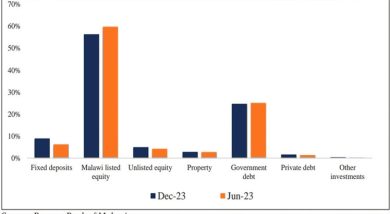Malawi’s GDP per capita stagnant
Malawi’s gross domestic product (GDP) per capita, a measure of a country’s economic output that accounts for its number of people, has been dormant for the past 55 years.
Figures from the Reserve Bank of Malawi (RBM) indicate that Malawi’s GDP per capita has stood at around $400 (about K296 000) per person per year from 1980, an indication that poverty levels in Malawi have not improved.

The RBM figures indicate that Malawi’s GDP per capita at $400 is also the lowest compared to other countries in the region such as Rwanda, Kenya and Ethiopia.
The figures indicate that Mauritius is one of the countries in the region with the fastest growing GDP per capita, which has moved from about $1 000 (about K740 000) per person per year to about $12 000 (about K8.8 million) between 1980 and 2019.
In an interview, RBM spokesperson Mbane Ngwira said there are a number of factors that have affected the country’s economic growth, with the major being weather patterns pointing that all recessions have been preceded by droughts.
He said: “Agriculture has been a dormant sector in contributing to economic growth. This has led to volatility in exchange and interest rates, reduction in private sector credit and increase in public debt.”
Ngwira is, however, upbeat that going forward, the stability recorded in the economy recently in most macroeconomic indicators will be a launch pad for sustainable economic growth and higher per capita income.
Economic commentators have argued that for a country to experience meaningful economic growth and move out of poverty, it should look beyond what is traditionally considered drivers of the economy.
“We have undergone so many regimes but none has equipped us with knowledge to jump out of the box. We have heavily depended on the same resources and kind of thinking to bring change.
“Poverty is now coming to the urban areas, but we seem to be playing a blind eye to this. It is, therefore, only when we look beyond what we think are drivers of economy when we can improve our poverty levels,” said University of Malawi’s Chancellor College economics professor Ben Kalua.
In its recent paper titled A DGE Model for Growth and Development Planning: Malawi, African Development Bank (AfDB) argued that Malawi needs to scale up public investment by 100 percent to $1.2 billion (about 912 billion) to double its per capita income.
AfDB argued that scaling up investment in the next five years could generate an average real GDP growth rate of 6.8 percent in short to medium-term which could drive nominal GDP up from the current $5.4 billion (about K4 trillion) to about $8 billion.





